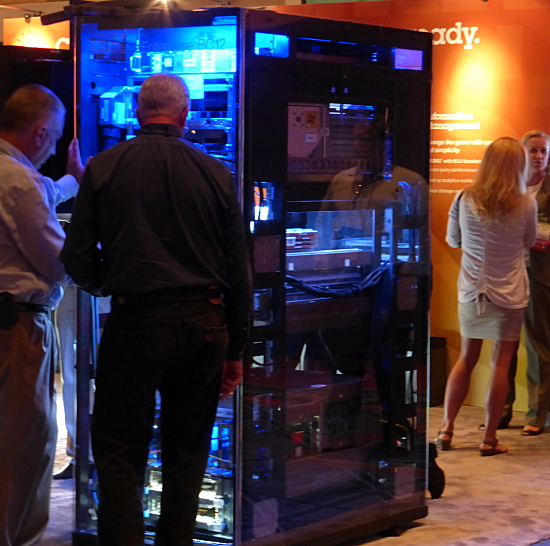Claudio Kitayama of Sicoob and Thiago Sobral of SUSE told the tale at SUSECon on Wednesday of how Linux on IBM’s System z saved the fast-growing Sicoob credit union, and how it became the second-largest Linux on System z installation in the world.
 Sicoob (Credit Unions System for Brazil) is the sixth largest financial institution in Brazil, and it was hampered by an aging and chaotic IT infrastructure. We’ve all been there: a nightmare of random hardware, aging and unsupported software, and mixed platforms put together with little planning or harmony. They had 310 Linux and Windows Intel servers running 1056 CPU cores red-lining at 90% CPU and memory, generating 883 BTU/h and costing over $50,000 per month in power bills. They were plagued with problems and slow performance. If they had continued to grow in the same way, they would now need 1,500+ servers, mondo staff to run them, and a $234,000 power bill.
Sicoob (Credit Unions System for Brazil) is the sixth largest financial institution in Brazil, and it was hampered by an aging and chaotic IT infrastructure. We’ve all been there: a nightmare of random hardware, aging and unsupported software, and mixed platforms put together with little planning or harmony. They had 310 Linux and Windows Intel servers running 1056 CPU cores red-lining at 90% CPU and memory, generating 883 BTU/h and costing over $50,000 per month in power bills. They were plagued with problems and slow performance. If they had continued to grow in the same way, they would now need 1,500+ servers, mondo staff to run them, and a $234,000 power bill.
In 2007 it became apparent doing more of the same was not going to work. Their IT was getting in the way, instead of moving Sicoob forward. After analyzing their business processes and growth forecasts they elected to consolidate, and ultimately replaced the raggle-taggle herd of Intel servers with three IBM System z mainframes and 20 mid-range servers running in a private cloud.
If you’re not familiar with mainframe computing, banking is a classic example of the types of workloads that mainframes are especially good at handling: high volumes of simultaneous transactions, massive databases, and five-nines reliability. Sicoob has over 50 DB2 databases on Linux virtual machines storing over 22 terabytes of data. The largest database is over 11 terabytes and it grows by 300 GB every month; this is the database that stores their scanned images of checks and other documents. With the old system they were processing a million check images per day, slowly. The new system handles 2 million daily with ease, with plenty of capacity for other tasks.
Kitayama explained that this new computing capacity has not reduced their staffing needs. On the contrary they have expanded their IT department, but for growth and improvements rather than scrambling to maintain an inefficient un-scalable system. They have been able to cut costs and roll out customer-pleasing new features such as online banking, mobile banking, and automated teller machines. They have also deployed sophisticated analytics and business intelligence software that provides comprehensive reporting for the whole company, replacing the old branch-level systems.
Two of their mainframes are System z196 equipped with 1136 GB RAM, and one z10 with 768 GB RAM, with multiple Linux VMs on the z/VM hypervisor and operating system. The original installation used SUSE Enterprise Linux 10, which was later upgraded to SLES 11 SP2. They calculate that this resulted in a 25 percent performance increase. Mainframe hardware is special: it’s not like commodity hardware. Every component has redundancy and failover built-in, and special performance enhancements, so the operating system has to be written to take advantage of the special hardware capabilities. Some of the improvements in SLES 11 included exploiting CPU instruction sets more efficiently, more CPU cache hits, and massively improved I/O.
The analytics software includes InfoSphere, Cognos Business Intelligence, and PureData System for Analytics. All the software runs natively on Linux. It is possible to run Linux on the bare hardware, in place of z/VM, but z/VM takes full advantage of all mainframe capabilities, while Linux is not quite there yet. Linux on z/VM is a great combination: z/VM for maximum bang for your mainframe buck, and the ease and flexibility of Linux for your workloads and applications.
The Bottom Line
Since 2007 Sicoob has more than doubled in size. Kitayama says they are saving around $3 million in energy costs annually, and the upgrade from SUSE 10 to 11 was worth a cool million in increased performance.


